PHYSICS CAPACITANCE THERE ARE 45 MARKS AVAILABLE SCORE
PHYSICS DEPARTMENT PROFORMA RESEARCH PROPOSAL CONFIRMATION FOR DIRECT1 PHYSICS OF BIOLOGICAL SYSTEMS CONRAD ESCHER HANSWERNER
10282004 PHYSICS 556714 NUCLEI AND ELEMENTARY PARTICLES PHY 556714
112 SPRINGS CALCULATION SHEET AQA PHYSICS QUESTIONS 1 WHEN
196 ANALYSING STARLIGHT FOLLOWUP SHEET OCR PHYSICS A WAVELENGTH
2 FOUNDATIONS OF PHYSICS CALCULATION SHEET OCR PHYSICS A
Module 1
Physics
Capacitance
There are 45 marks available.
Score: ________ Grade: _________
AfL:




|
Unit 4 |
Capacitors |
|
|
Lesson 15 |
||
|
To be able to calculate capacitance |
||
|
To be able to explain what happens as a capacitor charges up |
||
|
To be able to derive the energy stored by a capacitor |
MR. C - SJP |
|
C apacitors
apacitors
A capacitor is an electronic component that can store electrical charge and then release it.
It is made of two conducting plates separated by an insulator.
The charge that is stored by the capacitor is due to the potential difference across. We can write this as:
Q
![]() V or
Q =
kV
V or
Q =
kV
k is a constant specific to the capacitor, this is called the capacitance and is represented by the symbol C
![]()
Capacitance is measured in Farads, F
Charge is measured in Coulombs, C
We can rearrange the equation into C = Q / V and from this we can see that capacitance is a measure of the charge stored per volt of potential difference. 1 Farad means 1 Coulomb of charge is stored per Volt.
W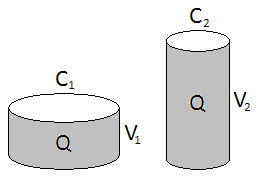 ater
Analogy
ater
Analogy
We can think of the charge stored by a capacitor as the volume of water in a bucket.
The cross-sectional area of the bucket represents the capacitance of the capacitor. We can see that the capacitance of capacitor 1 is higher than the capacitance of capacitor 2.
The height of the water represents the potential difference across the capacitor. We can see that the potential difference across capacitor 2 is higher than the p.d. across capacitor 1. The charge stored by both capacitors is the same.
A capacitor with a lower capacitance can store more charge if the p.d. across it is increased.
Charging and Discharging
When a capacitor is connected to a battery is sends out electrons to one of the plates, this becomes negatively charged. The same amount of electrons move from the second plate and enter the battery, leaving the plate positively charged. The capacitor is now storing a charge or is ‘charged’.
If the charged capacitor is disconnected from the battery and connected to a lamp it will give out the stored charge or will ‘discharge’. The electrons on the negative plate move through the circuit and onto the positive plate. The plates now have no charge on them. The energy stored by the capacitor is transferred to the bulb whilst the electrons move (whilst a current flows).
E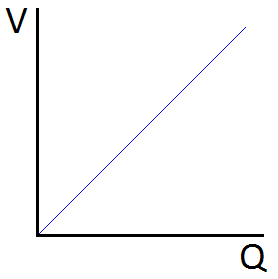 nergy
Stored by a Capacitor
nergy
Stored by a Capacitor
The top equation shows us that the charge of a capacitor increases with the potential difference across it. If we plotted p.d. against charge we get a graph that looks like this
W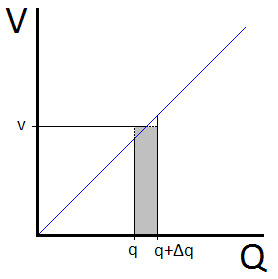 e
can derive an equation to find the energy that a capacitor stores by
considering the energy transferred during the shaded section on the
lower graph.
e
can derive an equation to find the energy that a capacitor stores by
considering the energy transferred during the shaded section on the
lower graph.
In this section the charge changes from q to q+Δq when an average p.d. of v is applied across it.
Using E = VQ (see AS Unit 1) the energy stored is E = v Δq.
The total energy is equal to the total of all the little rectangular sections and is given by E = ½ QV. This is also equal to the area under the graph.
We can use the top equation to derive two more equations for the energy stored by a capacitor:
![]()
![]()
![]()
Energy is measured in Joules, J
|
Unit 4 |
Charging and Discharging |
|
|
Lesson 16 |
||
|
To be able to sketch graphs of charge, p.d. and current over time for a charging capacitor |
||
|
To be able to sketch graphs of charge, p.d. and current over time for a discharging capacitor |
||
|
To be able to calculate the time constant and state its significance |
MR. C - SJP |
|

In the diagram to the right a capacitor can be charged by the battery if the switch is moved to position A. It can then be discharged through a resistor by moving the switch to position B.
Charging a Capacitor
When the switch is moved to A the battery sends electrons to the lower plate and takes them from the upper plate. This leaves the lower plate negatively charged and the upper plate positively charged. An electric field is set up between the plates.
Current The current is the flow of electrons through the circuit (see Unit 1). There is a large current initially as electrons move to the lower plate. As time passes and more electrons are on the plate it becomes more difficult to add more due to the electrostatic repulsion of similar charges. When no more electrons move in the circuit the current drops to zero.
Charge The charge stored by the capacitor increases with every electron the moves to the negative plate. The amount of charge increases quickly at the beginning because a large current is flowing. As the current drops the rate at which the charge increases also drops. A maximum charge is reached.
P.D. Since potential difference is proportional to charge, as charge builds up so does p.d. The maximum value of p.d. is reached as is equal to the terminal p.d. of the battery.
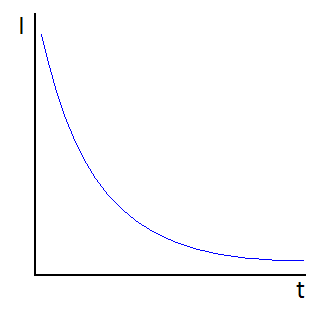

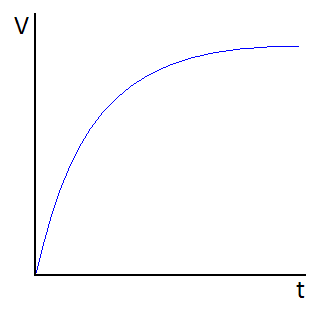
Discharging a Capacitor
When the switch in moved to B the electrons on the negative plate repel each other and move back into the circuit. Eventually both plates lose their charge and the electric field between them disappears.
Current There is initially a large current as the electrons leave the negative plate. As the number of electrons on the negative plate falls so does the size of the repulsive electrostatic force, this makes the current fall at a slower rate. When no more electrons move in the circuit the current drops to zero.
Charge The charge that was stored on the plates now falls with every electron that leaves the negative plate. The charge falls quickly initially and then slows, eventually reaching zero when all the charge has left the plates.
P.D. As the charge falls to zero so does the potential difference across the capacitor.



Time Constant, τ
The time it takes for the capacitor to discharge depends on the ‘time constant’.
The time constant is the time it takes for the charge or p.d. of a capacitor to fall to 37% of the initial value. OR
The time constant is the time it takes for the charge or p.d. of a capacitor to fall by 63% of the initial value.
It is given by the equation:
![]()
If the capacitor has a larger capacitance it means it can hold more charge, this means it will take longer to discharge. If the resistor has a larger resistance it means it is harder to move the electrons around the circuit, this also means it will take longer to discharge.
|
Unit 4 |
Exponential Decay |
|
|
Lesson 17 |
||
|
To be able to calculate the charge of a discharging capacitor after a time, t |
||
|
To be able to calculate the potential difference across a discharging capacitor after a time, t |
||
|
To be able to calculate the current through a discharging capacitor after a time, t |
MR. C - SJP |
|
Finding τ from Graphs
The time constant of a discharging capacitor can be found from a graph of either charge, current or potential difference against time. After one time constant the value will have dropped to 0.37 of the initial value.

In this case the time constant is 4 seconds.
Quantitative Treatment
We could use the graph above to find the charge on the capacitor after a time, t. We could also use it to find the time it takes for the charge to fall to a value of Q.
This requires the graph to be drawn very accurately and values need to be taken from it very carefully.
Instead of doing this we can use the following equation to calculate the charge, Q after a time, t.
![]()
t is the time that has elapsed since discharge began
Q is the remaining charge
Q0 is the initial (or starting) charge
RC is the time constant, also equal to the resistance multiplied by the capacitance.
Time is measured in seconds, s
When the time elapsed is equal to the time constant the charge should have fallen to 37% of the initial value.
![]()
![]()
![]() (but e-1
= 0.37)
(but e-1
= 0.37)
![]()
When the time elapsed is equal to twice the time constant the charge should have fallen to 37% of 37% of the initial value.
![]()
![]()
![]() (but e-2
= 0.37 x 0.37)
(but e-2
= 0.37 x 0.37)
![]()
Similar equations can be established for the current flowing through and the potential difference across the capacitor after time, t:
![]()
![]()
![]()
Rearranging
The equations above can be rearranged to make t the subject. We will use the equation for charge:
![]()
![]()
![]()
![]()
![]()
They can also be rearranged to make RC (time constant) the subject:
![]()
![]()
![]()

Q1.An uncharged 4.7 nF capacitor is connected to a 1.5 V supply and becomes fully charged.
How many electrons are transferred to the negative plate of the capacitor during this charging process?
A 2.2 × 1010
B 3.3 × 1010
C 4.4 × 1010
D 8.8 × 1010
(Total 1 mark)
Q2.When fully charged the 2.0 mF capacitor used as a backup for a memory unit has a potential difference of 5.0 V across it. The capacitor is required to supply a constant current of 1.0 μA and can be used until the potential difference across it falls by 10%. For how long can the capacitor be used before it must be recharged?
A 10 s
B 100 s
C 200 s
D 1000 s
(Total 1 mark)
Q3.(a) The graph shows how the current varies with time as a capacitor is discharged through a 150 Ω resistor.

(i) Explain how the initial charge on the capacitor could be determined from a graph of current against time.
...............................................................................................................
...............................................................................................................
...............................................................................................................
...............................................................................................................
(1)
(ii) The same capacitor is charged to the same initial potential difference (pd) and then discharged through a 300 kΩ resistor. Sketch a second graph on the same axes above to show how the current varies with time in this case.
(3)
(b) In an experiment to show that a capacitor stores energy, a student charges a capacitor from a battery and then discharges it through a small electric motor. The motor is used to lift a mass vertically.
(i) The
capacitance of the capacitor is 0.12 F and it is charged to a pd of
9.0 V.
The weight of the mass raised is 3.5 N.
Calculate
the maximum height to which the mass could be raised.
Give your
answer to an appropriate number of significant figures.
maximum height ................................................. m
(4)
(ii) Give two reasons why the value you have calculated in part (i) would not be achieved in practice.
1 ............................................................................................................
...............................................................................................................
...............................................................................................................
...............................................................................................................
2 ............................................................................................................
...............................................................................................................
...............................................................................................................
...............................................................................................................
(2)
(Total 10 marks)
Q4.A 10μF capacitor is connected across the terminals of a 100 V d.c. power supply and allowed to charge fully.
(a) Calculate
(i) the charge on the capacitor,
...............................................................................................................
...............................................................................................................
(ii) the energy stored by the capacitor.
...............................................................................................................
...............................................................................................................
(2)
(b) The fully-charged capacitor is disconnected from the power supply and connected via two wires across the terminals of an uncharged 10 μF capacitor as shown.

The charge on the original 10 μF capacitor is shared equally between the capacitors in the parallel combination.
(i) Calculate the potential difference across the terminals of each capacitor.
...............................................................................................................
...............................................................................................................
(ii) Calculate the total energy stored by the two capacitors.
...............................................................................................................
...............................................................................................................
(iii) Account for the difference between the energy stored by the two capacitors in parallel and that stored by the original single 10 μF capacitor.
...............................................................................................................
...............................................................................................................
...............................................................................................................
...............................................................................................................
(4)
(Total 6 marks)
Q5.The figure below shows a capacitor of capacitance 370 pF. It consists of two parallel metal plates of area 250 cm2. A sheet of polythene that has a relative permittivity 2.3 completely fills the gap between the plates.
![]()
not
to scale
(a) Calculate the thickness of the polythene sheet.
thickness = _____________m
(2)
(b) The capacitor is charged so that there is a potential difference of 35 V between the plates. The charge on the capacitor is then 13 nC and the energy stored is 0.23 µJ.
The supply is now disconnected and the polythene sheet is pulled out from between the plates without discharging or altering the separation of the plates.
Show that the potential difference between the plates increases to about 80 V.
(2)
(c) Calculate the energy that is now stored by the capacitor.
energy stored = _____________µJ
(2
(d) Explain why there is an increase in the energy stored by the capacitor when the polythene sheet is pulled out from between the plates.
........................................................................................................................
........................................................................................................................
........................................................................................................................
........................................................................................................................
(2)
(Total 8 marks)
Q6. Capacitors and rechargeable batteries are examples of electrical devices that can be used repeatedly to store energy.
(a) (i) A capacitor of capacitance 70 F is used to provide the emergency back-up in a low voltage power supply.
Calculate the energy stored by this capacitor when fully charged to its maximum operating voltage of 1.2 V. Express your answer to an appropriate number of significant figures.
answer = ...................................J
(3)
(ii) A rechargeable 1.2 V cell used in a cordless telephone can supply a steady current of 55 mA for 10 hours. Show that this cell, when fully charged, stores almost 50 times more energy than the capacitor in part (a)(i).
(2)
(b) Give two reasons why a capacitor is not a suitable source for powering a cordless telephone.
Reason 1.....................................................................................................
.....................................................................................................................
Reason 2......................................................................................................
......................................................................................................................
(2)
(Total 7 marks)
Q7.The diagram below shows an arrangement to demonstrate sparks passing across an air gap between two parallel metal discs. Sparks occur when the electric field in the gap becomes large enough to equal the breakdown field strength of the air. The discs form a capacitor, which is charged at a constant rate by an electrostatic generator until the potential difference (pd) across the discs is large enough for a spark to pass. Sparks are then produced at regular time intervals whilst the generator is switched on.

(a) The electrostatic generator charges the discs at a constant rate of 3.2 × 10–8 A on a day when the minimum breakdown field strength of the air is 2.5 × 106 V m–1. The discs have a capacitance of 3.7 × 10–12 F.
(i) The air gap is 12 mm wide. Calculate the minimum pd required across the discs for a spark to occur. Assume that the electric field in the air gap is uniform.
pd ......................................... V
(1)
(ii) Calculate the time taken, from when the electrostatic generator is first switched on, for the pd across the discs to reach the value calculated in part (a)(i).
time .......................................... s
(2)
(b) The discs are replaced by ones of larger area placed at the same separation, to give a larger capacitance.
State and explain what effect this increased capacitance will have on:
(i) the time between consecutive discharges,
...............................................................................................................
...............................................................................................................
...............................................................................................................
...............................................................................................................
...............................................................................................................
(2)
(ii) the brightness of each spark.
...............................................................................................................
...............................................................................................................
...............................................................................................................
...............................................................................................................
...............................................................................................................
(2)
(Total 7 marks)
Q8.The graph below shows how the charge stored by a capacitor varies with time when it is discharged through a fixed resistor.
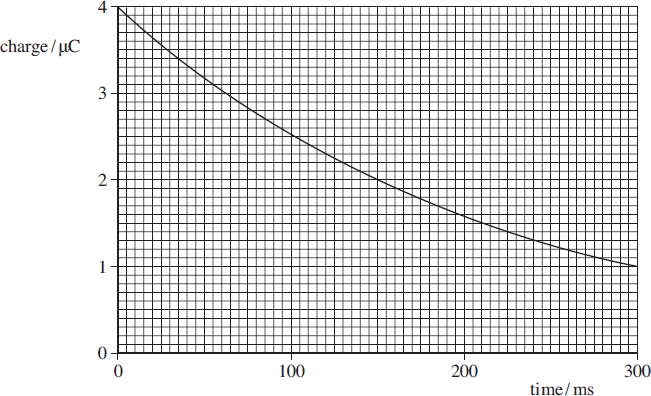
(a) Determine the time constant, in ms, of the discharge circuit.
time constant ............................... ms
(3)
(b) Explain why the rate of discharge will be greater if the fixed resistor has a smaller resistance.
........................................................................................................................
........................................................................................................................
........................................................................................................................
........................................................................................................................
........................................................................................................................
(2)
(Total 5 marks)
2 SOLID STATE PHYSICS (INDIA) 45 (2002) XXXXXY PROCEEDINGS
20TH GAMOW INTERNATIONAL ASTRONOMICAL CONFERENCESCHOOL ASTRONOMY AND BEYOND ASTROPHYSICS
295407-electricity-sensing-waves-and-quantum-physics-mcq-topic-quiz-lesson-element
Tags: capacitance, marks, available, score, there, physics
- MAKING CONNECTIONS COURSE CATALOG FROM THE DEPARTMENT OF COUNSELING
- ROZLOSOVÁNÍ 2015 DVOUHRA MUŽI HRÁČ Č SKUPINA A SKUPINA
- BRIDGE PROGRAM FOCUS GROUPS SUMMER 2005 SUMMARY OF
- AUSTRALIAN HERITAGE DATABASE PLACES FOR DECISION CLASS HISTORIC
- I ALMEN SPROGFORSTÅELSESFORLØBET ARBEJDES DER BREDT MED SPROG HENSIGTEN
- LATVIJAS REPUBLIKAS FINANŠU MINISTRIJAS EIROPAS SAVIENĪBAS FONDU
- CONCEPTO NO 019747 DEL 17 DE JUNIO DE 2004
- “13° RONDA DE NEGOCIOS INTERNACIONAL DE DISEÑO 2017” FERIA
- AUKŠTAITIJOS REGIONO ASOCIACIJA „ARTRITAS“ ĮM KODAS 190860470 NEVĖŽIO G
- PERSYARATAN IZIN GANGGUANHO PERMOHONAN IZIN GANGGUAN DIAJUKAN SECARA TERTULIS
- TVIRTINU KALESNINKŲ LIUDVIKO NARBUTO GIMNAZIJOS DIREKTORĖS PAVADUOTOJA UGDYMUI JULIANA
- PROFIL PEJABAT STRUKTURAL PADA DINAS PEKERJAAN UMUM DAN PENATAAN
- (ACTUALIZADA AL 21112014 A PROPÓSITO DE LA PUBLICACIÓN DEL
- КАРТА СМАЗКИ ДЛЯ ГРУЗОВИКОВ DAF (EURO 3) УЗЛЫ ТИПЫ
- DAFTAR RIWAYAT HIDUP A KETERANGAN PERORANGAN NAMA LENGKAP
- 2.%20DAFTAR%20RIWAYAT%20HIDUP
- KOP SURAT PT XYZ SURABAYA SEPTEMBER 2016 NO
- BIBLIOGRAPHY OF WORKS ON TIMOR LESTE (EAST TIMOR) HELD
- GUÍA TÉCNICA PARA LA ELABORACIÓN DE PLANES DE EMERGENCIA
- KEMENTERIAN RISET TEKNOLOGI DAN PENDIDIKAN TINGGI POLITEKNIK NEGERI BANDUNG
- LATVIJAS REPUBLIKA VALSTS VIDES DIENESTS DAUGAVPILS REĢIONĀLĀ
- KEMENTERIAN PENDIDIKAN KEBUDAYAAN RISET DAN TEKNOLOGI UNIVERSITAS SUMATERA UTARA
- 1 FORMAT SURAT PERMOHONAN PENDATAAN DALAM DATABASE ORMAS KOP
- LAMPIRAN A1 CONTOH COVER DEPAN LAPORAN KERJA PRAKTEK JUDUL
- FORMULARIO DE POSTULACIÓN 2022 EL PRESENTE DOCUMENTO DEBE SER
- CONSEJERÍA DE EDUCACION ESCUELA OFICIAL DE IDIOMAS DE GRANADA
- ROLLEBESKRIVELSER EHANDEL I DETTE DOKUMENTET BESKRIVES ROLLER TILKNYTTET EHANDELSPROSESSEN
- POWERPLUSWATERMARKOBJECT3 NADCAP MANAGEMENT COUNCIL MARCH 2011 UNCONFIRMED MINUTES MARCH
- FICHA SOLICITUD DE RESERVA DE VISITA ´ FICHA DE
- DOBLA ORTOGRAFIA FAUTAS VERTADIERAS ACCENTS SUPERFLÚS E FRANCISMES SUPAUSATS
 BAB 12 KOLOM TINJAUAN INSTRUKSIONAL KHUSUS MAHASISWA
BAB 12 KOLOM TINJAUAN INSTRUKSIONAL KHUSUS MAHASISWA 45 REF EXPEDIENTE NO 110010325000201200888 00 NO INTERNO 27282012
45 REF EXPEDIENTE NO 110010325000201200888 00 NO INTERNO 27282012221 SECOND GRADE BIG IDEA CONSTRUYENDO PUENTES GUIDING THOUGHT
ENG 497302 SEMINAR SHAKESPEARE’S KING LEAR AND KING HENRY
 HLASOVÉ SLUŽBY POSKYTOVANÉ PROSTŘEDNICTVÍM IP PROTOKOLU (VOIP) ZPRACOVAL
HLASOVÉ SLUŽBY POSKYTOVANÉ PROSTŘEDNICTVÍM IP PROTOKOLU (VOIP) ZPRACOVALHRVATSKI SABOR 2428 NA TEMELJU ČLANKA 89 USTAVA REPUBLIKE
 ILFUNTANA TA’ GĦAJN RAŻUL ILLEĠĠENDA TGĦID LI META SAN
ILFUNTANA TA’ GĦAJN RAŻUL ILLEĠĠENDA TGĦID LI META SAN PROF EDWARD CHLEBUS PRONET COORDINATOR WROCLAW UNIVERSITY OF TECHNOLOGY
PROF EDWARD CHLEBUS PRONET COORDINATOR WROCLAW UNIVERSITY OF TECHNOLOGY SPECIAL EDUCATION PROCESS FROM CHILDFIND REFERRAL EVALUATION AND ELIGIBILITY
SPECIAL EDUCATION PROCESS FROM CHILDFIND REFERRAL EVALUATION AND ELIGIBILITYTHE VIRTUAL CITIES PROJECT UNIVERSITY OF CALGARY PRESS UNIVERSITY
SPIEGAZIONE DEL CALCOLO DEL VOTO DI PARTENZA PER LA
NEW HOLLOW CYLINDER TORSIONAL APPARATUS (HCTA) SERGIO VALDUEZA LOZANO
EL ASESORAMIENTO FILOSÓFICO Y LAS EMOCIONES APLICACIÓN DE LAS
 COMITÊ DE PRONUNCIAMENTOS CONTÁBEIS PRONUNCIAMENTO TÉCNICO CPC 48 INSTRUMENTOS
COMITÊ DE PRONUNCIAMENTOS CONTÁBEIS PRONUNCIAMENTO TÉCNICO CPC 48 INSTRUMENTOSREQUERIMIENTOS VOLUMEN TOTAL DE LA MUDANZA 30 M3 SE
MINISTERIO DE EDUCACION NACIONAL FORMATOS PARA LA PRESENTACIÓN
AUDIT I PONIŻEJ NAKREŚLONO PRZEBIEG AUDITU W PRZEDSIĘBIORSTWIE GRUPA
 ZIEMIA WE WSZECHŚWIECIE IMIĘ I NAZWISKO PONIŻSZY TEST
ZIEMIA WE WSZECHŚWIECIE IMIĘ I NAZWISKO PONIŻSZY TEST P3 MERILA ZA OCENJEVANJE VLOG ZA POSVETE M ESTNA
P3 MERILA ZA OCENJEVANJE VLOG ZA POSVETE M ESTNA 1585126941-PERDA_19_20041
1585126941-PERDA_19_20041